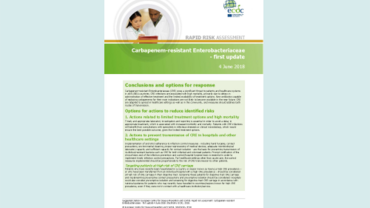Carbapenem resistant Enterobacteriaceae - second update
Carbapenem resistance in Enterobacteriaceae such as Klebsiella pneumoniae and Escherichia coli poses a significant threat to patients and healthcare systems in all European Union/European Economic Area (EU/EEA) countries. Carbapenem-resistant Enterobacteriaceae (CRE) infections are associated with high mortality, primarily due to delays in administration of effective treatment and the limited availability of treatment options. Hypervirulent carbapenem-resistant K. pneumoniae strains have been reported presenting an additional threat with a potential for global dissemination. The spread of high risk clones and plasmids carrying carbapenemases in healthcare settings is a major cause of the spread of CRE in EU/EEA countries. Recent events of cross-border importation after patient transfer and large regional outbreaks as well as the worsening epidemiologic situation of carbapenemase-producing CRE in the EU/EEA highlight the high risk for further spread of CRE and the need for enhanced control efforts. Options for control are outlined in the respective section below.
Download








